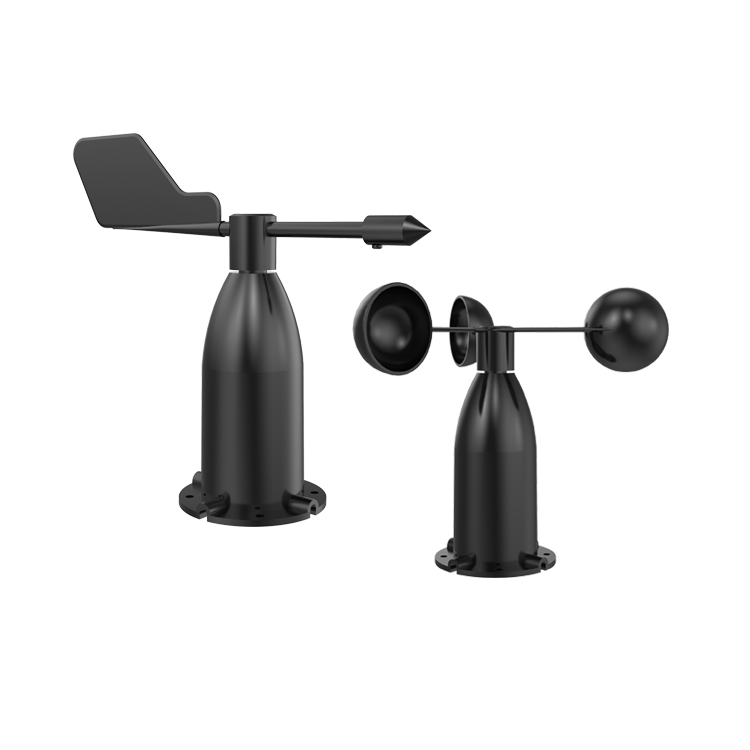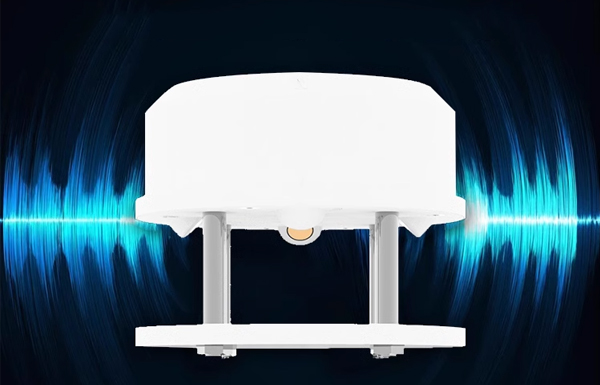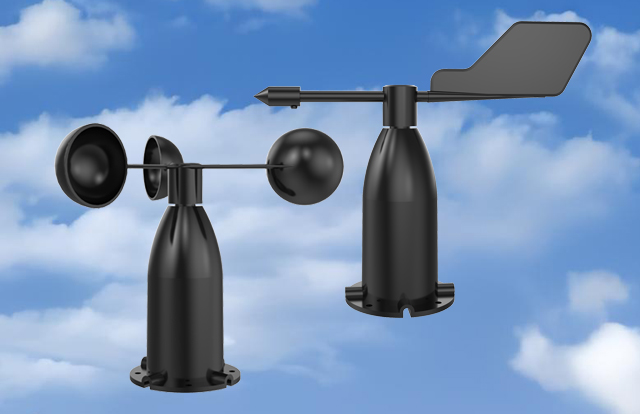


The wind sensor support the development of new energy wind power generation technology. Wind speed and direction are also related to the layout of buildings and the effect of natural ventilation.
The sensing element of the wind speed sensor is a three-cup wind cup, and the signal conversion circuit is a photoelectric conversion. Driven by horizontal wind force, the wind cup group rotates, and the infrared grating on it senses a pulse signal through the rotating code disk, and its frequency increases with the increase of wind speed.
The wind direction sensor is a resistive wind direction monitor. It uses a structure similar to a sliding rheostat, and the resistance value generated is marked as 360° and 0° respectively. When the wind vane rotates, the sliding rod of the sliding rheostat will rotate with the wind vane at the top, and the different voltage changes generated can calculate the angle or direction of the wind direction.
When ultrasonic waves encounter fluid movement in the air, the propagation speed of the ultrasonic waves will change due to the different fluid speeds. This causes changes in the frequency and phase of the ultrasonic waves. The receiver in the sensor can receive the reflected ultrasonic signal and then convert it into an electrical signal output. Based on these input signals, through signal processing and algorithm analysis, the ultrasonic wind sensor can calculate the wind speed and direction in the air.
The price of a three-cup wind speed sensor is generally tens of dollars, and the aluminum shell material is more expensive than the polycarbonate material. The price of a wind direction sensor is also tens of dollars, and the measurement range of 0-360° is more expensive than the eight-direction and 16-direction sensors. The price of an ultrasonic wind sensor usually ranges from a few hundred to a few thousand dollars. The higher the price, the more accurate the measurement results.

In order to ensure the reliability of wind speed sensor data and the traceability and quality assurance of measurement, the wind speed sensor must be calibrated from time to time.
1. Appearance inspection
The shape and size of the wind cup should be the same, the angle between the two adjacent arms should be equal, and the rotation plane should be perpendicular to the axis of the fuselage or the center axis.
The wind cup should be able to balance in any situation, rotate flexibly and smoothly, and there should be no obvious axial or radial runout.
The cables and components of the wind speed sensor have no obvious defects and good sealing
2. Required measuring instruments
Temperature and humidity sensor, micro differential pressure transmitter, atmospheric pressure sensor, Pitot tube, differential pressure transmitter, annular low-speed wind tunnel.
All measuring instruments used should be measured to ensure accuracy.
After the measuring instruments are ready, the equipment needs to be placed in the designated location. The wind speed sensor that has been repaired or not used for a long time should be operated at a wind speed of 10m/s for 2-3 minutes. After adjusting the equipment, turn on the machine and slowly increase the airflow speed in the wind tunnel until the wind cup changes from static to continuous rotation, and read the display value of the micromanometer and the display value of the wind speed sensor. According to the value measured by the pitot tube, calculate the airflow speed value in the working section of the wind tunnel, which is the starting wind speed of the wind speed sensor. If the measured wind speed is greater than 1.5m/s, no further calibration will be performed.
The number of wind speed indication calibration points should be greater than or equal to 5. After each calibration point is adjusted, it should be stable for 1-2 minutes. When the indication of the measuring instrument is stable, the value is valid.

The calibration of the wind direction sensor and the calibration of the wind speed sensor are very similar. They are both calibrated in the wind tunnel. The measurement range of wind direction is 0°-360°. When the wind speed in the wind tunnel is 2m/s, the arrow or tail of the wind direction sensor should rotate, and the angle with the airflow direction (displayed by the standard azimuth disk of the wind tunnel) should not exceed ±10°. The allowable indication error of the wind direction of the wind direction sensor: ±5° for the propeller type
1. Appearance inspection
The shape and size of the wind vane should be the same, the angle between the adjacent arms should be equal, and the rotation plane should be perpendicular to the axis of the fuselage or the center axis.
The arrow and tail of the wind vane should be able to balance in any situation, rotate flexibly and smoothly, and there should be no obvious axial or radial runout.
The cables and components of the wind speed sensor have no obvious defects and good sealing
2. Wind direction calibration
Place the wind direction sensor in the working section of the wind tunnel. The installation direction should be coaxial and vertical with the standard square tail plate of the wind tunnel. The standard square tail plate of the wind tunnel is installed below the wind direction sensor axis. At the center of the bottom plate of the wind tunnel working section, the 0° and 180° axes are parallel to the central axis of the airflow in the wind tunnel working section, and 0° is aligned with the airflow inlet direction.
The angles between the arrow of the wind direction sensor and the airflow direction of the wind tunnel are 30°, 150°, 170°, 190°, 210°, and 330° respectively. Measure clockwise and counterclockwise respectively. Before measuring, the angle must be adjusted first, and then the machine is turned on. The wind speed increases slowly, less than or equal to 2m/s, and observation is carried out at the wind tunnel observation port. The wind vane arrow should rotate and the angle with the airflow direction should be less than ±10°.
1. Fix the ultrasonic wind sensor on the test point to ensure that the instrument is stable and reliable.
2. Use a standard anemometer to compare and calibrate the ultrasonic wind sensor.
3. Adjust the parameters of the ultrasonic wind sensor according to the calibration results, including wind speed, wind direction, etc.
4. Repeat the calibration until the expected accuracy and stability are achieved. The calibration of ultrasonic wind sensors requires strict compliance with relevant regulations to ensure the accuracy and reliability of the measurement data.
